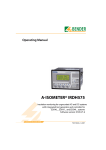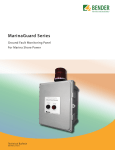Download Installation Bulletin: IRDH575
Transcript
IRDH575 Installation Bulletin / Reference Guide This document is intended as a reference guide for installing and using a BENDER IRDH575 ground fault detector. This document includes installation, setup, and usage instructions. For complete details, including installation, setup, settings, and troubleshooting, refer to the IRDH575 user manual, document number TGH1364en. This document is intended as a supplement and not a replacement to the complete user manual. Only qualified maintenance personnel shall operate or service this equipment. These instructions should not be viewed as sufficient for those who are not otherwise qualified to operate or service this equipment. This document is intended to provide accurate information only. No responsibility is assumed by BENDER for any consequences arising from use of this document. Installation Wiring - EDS modules System Requirements Properly implementing an installed ground fault location system requires multiple components. The types of components used vary depending on the type of system. Ensure that you have the correct components in one of the combinations listed below: EDS460 and EDS490 series ground fault location devices work with the IRDH575 to locate ground faults on ungrounded systems. Refer to EDS series user manual (document TGH1420en) and EDS series installation bulletin (document NAE1018070) for information on installing EDS series modules. Type 1: Standard distribution systems Type 2: Small distibution systems Wiring - RS-485 Minimum RS-485 Requirements For proper operation of automatic ground fault location, an RS-485 connection is required between the ground fault detector and the EDS module(s). All devices shall be wired in series with each other via each device’s “A” and “B” terminals. Devices at the beginning and end of the chain require a 120 Ω termination resistor. Most devices have a switch to activate the termination resistor. Refer to the respective device’s user manual for more information. Refer to figure 2 for a sample diagram. • IRDH575 series ground fault detector, with location signal set between 10 mA and 25 mA, qty. 1 • IRDH575 series ground fault detector, with location signal set no higher than 2.5 mA; Qty. 1 • EDS460 / EDS490 series ground fault location module, qty. dependent on number of monitored branches • EDS461 / EDS491 series ground fault location module, qty. dependent on number of monitored branches • One BENDER current transformer per branch. See section “Wiring - Current Transformers” for a list of compatible current transformers. • One of the following BENDER current transformers per branch: W20-8000, W35-8000, W60-8000 Mounting The IRDH575 is a panel-mounted device. When mounting, use a cutout of 5.4” x 3.5” (138 mm x 90 mm). Wiring See figure 1 for basic wiring schematic. The IRDH575 uses plug-in terminals located on the back of the device. See section “Wiring - RS-485” on additional requirements for wiring to EDS series ground fault location modules. Use minimum AWG 24, maximum AWG 12 wire. For more information, refer to the IRDH575 user manual and EDS series user manual. ! DANGER Communication Bus Address Settings Each device must be set with a unique communication bus address. Refer to the reverse side of this document for setting the address on EDS modules. Refer to the respective device’s documentation for setting the address on other devices. Expanding Communication Bus Multiple BENDER ground fault location systems, along with other select BENDER equipment, may be interconnected via RS-485. Only the first and last devices in the completed communication bus require termination resistors. Repeater Requirements For every 3900 ft (1200 m) OR for every 32 connected devices (whichever comes first), an RS485 repeater (mfgr. P/N DI-1) is required to be installed. HAZARD OF ELECTRIC SHOCK, EXPLOSION, OR ARC FLASH • Disconnect all power before servicing. • Observe all local, state, and national codes, standards, and regulations. 2 IRDH575 3 EDS460-D EDS460-L COM460IP 4 Figure 2 - Sample RS-485 wiring with IRDH575, EDS modules, and COM460IP Ethernet gateway 1 5 11 9 13 12 7 6 Front Panel Display 8 10 Insulation Fault 5 6 7 Figure 1 - IRDH575 wiring diagram 1. External supply voltage; 6A fuse recommended for internal device protection 9. 2. Connection to three-phase AC system 10. RS-485 interface 3. Connection to single-phase AC system 11. Alarm relay K1: SPDT contact 4. Connection to DC system 12. Alarm relay K2: SPDT contact 5. Equipment ground connection 13. Alarm relay K3: SPDT contact 6. External TEST terminal, N/O contact 7. External RESET terminal, N/O contact 8. STANDBY terminals: Closing F1/F2 will stop measurements 1 Analog outputs: 0... 400 μA on standard version, 0/4... 20 mA on “B” version Bender Inc. • 800.356.4266 / 610.383.9200 • [email protected] • www.bender.org 2 3 4 8 9 1 is active. 1. INFO / ESC key: Displays system information / goes back a step in menu 6. 2. TEST / UP key: Initiates self-test / moves up in menu LED “ALARM 2”: Illuminates when alarm 2 is active. 7. 3. RESET / DOWN key: Resets device when latching mode is active / moves down in menu LED “ERROR”: Illuminates when a device error has occured. 8. LED “EDS ACTIVE”: Indicates when fault location has been activated. 4. MENU / ENTER key: Opens the main menu / confirms changes in menu 9. LED “EDS ALARM”: Indicates when an alarm is active on a connected EDS. 5. LED “ALARM 1”: Illuminates when alarm Document NAE1018060 • 10.2011 • © Bender Inc. • Page 1/1 • Side 1/2 IRDH575 Installation Bulletin / Reference Guide Menu Structure Flow Chart Using the Fault Location System Figure 5 shows the structure of the menu built into the IRDH575. The menu is used for viewing alarms, viewing the status of the system, and making any necessary settings changes. Use the supplied gray boxes to take note of applied settings for future reference. Most ground fault location processes will be automated when connecting the IRDH575 and supported EDS modules via RS-485. When the IRDH575 detects a ground fault in the system, the location system will automatically activate. The IRDH575 will superimpose a tracer signal onto the circuit. This tracer signal naturally flows through the ground fault, back to the IRDH575. Connected EDS modules will monitor each branch of the circuit for this tracer signal, and alarm when it is found. The address and location of the faulty branch will be reported on the screens of both the EDS module(s) (“D” versions only) and the IRDH575. The mA value shown indicates the strength of the tracer signal found. Menu or settings option Settings option essential for proper operation IRDH575 Display During Fault Location 1. EXIT Insulation Fault 2. HISTORY INFO 3. ISO SETUP 4. ISO ADVANCED 5. EDS SETUP 1 2 3 1. Exit 2.Alarm1 1 kΩ... 10 MΩ 3. Alarm2 1 kΩ... 10 MΩ 4. K1 N/O-T N/C-T N/C N/O Flash 5. K2 N/O-T N/C-T N/C N/O Flash Memory on 7. M+/M- 0-20 mA 4-20 mA off 2.AGH no 3. Ce max 150 500 4. Measure AMP DC 5. Autotest 24 no 01 6. Clock 00:00 7. Date dd.mm.yy 8. Test 00:00 ... 23:00 4 1. Insulation resistance reading: “s” is displayed when a new reading is aquired 2. Status of fault location: “On” indicates fault location is currently active. 3. Displays when EDS has located fault. “ADR” indicates address of EDS device. “k” indicates branch number in alarm. 1. Exit 5 4. Magnitude of tracer signal located 5. “H” displays when a new record has been added to the IRDH575’s history memory Device Setup Tips 1. Exit 2. EDS auto on off 3. System DC AC 3AC 4. MaxPuls 1 25 2.5 50 10 5. K3 Alarm on off • Ensure that all menu options in red in the menu structure flow chart are set correctly. Incorrect settings may lead to improper readings. • Menu options “EDS460/490” and “EDS470” may be used to remotely configure EDS modules connected via RS-485. This is optional for “D” models but mandatory for configuring “L” models. Consult the EDS series user manual for more information. • When connected to EDS modules via RS-485, menu option EDS SETUP > EDS must be set to “auto” for proper automatic ground fault location. • Setting EDS SETUP > MaxPuls MUST be set correctly for the corresponding connected EDS modules. See below: • When using EDS460 or EDS490 modules, set MaxPuls to 10 or 25 mA. • When using EDS461 or EDS491 modules, set MaxPuls to 1 or 2.5 mA. Analog Outputs IRDH575 models feature a 0 - 20 mA or 4 - 20 mA output, selectable in the main menu under ISO SETUP > M+/M-. For integrating the analog outputs into control systems, refer to the equations below for the type of analog output being used. 6. EDS460/490 7. EDS470 8. COM SETUP 9. PASSWORD 10. LANGUAGE 1. Exit 0 - 20 mA output 2. Addr. 1 ... 30 4. ISO Monitor 1 ... 30 RF I Insulation resistance in kΩ Current output in mA RF I Insulation resistance in kΩ Current output in mA 1. Exit 2. Password 000 ... 999 3. Status on off 4 - 20 mA output 1. Exit 2. Text English Deutsch 11. SERVICE Figure 5 - IRDH575 menu flow chart Technical Data Refer to IRDH575 series user manual (document TGH1364en) or IRDH575 series datasheet (document NAE1012050) for detailed technical information. Bender Inc. • 800.356.4266 / 610.383.9200 • [email protected] • www.bender.org Document NAE1018060 • 10.2011 • © Bender Inc. • Page 1/1 • Side 2/2









